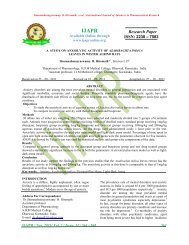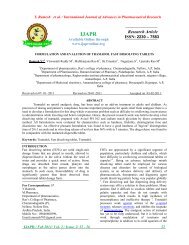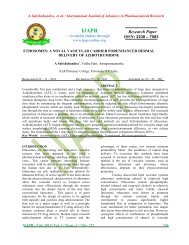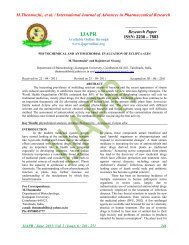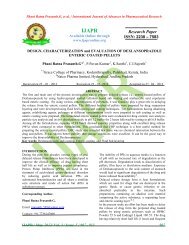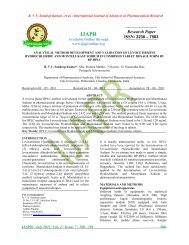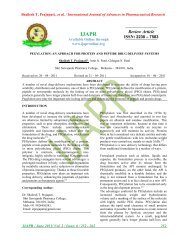20110424_kiran et al IJAPR.pdf - international journal of advances ...
20110424_kiran et al IJAPR.pdf - international journal of advances ...
20110424_kiran et al IJAPR.pdf - international journal of advances ...
Create successful ePaper yourself
Turn your PDF publications into a flip-book with our unique Google optimized e-Paper software.
B. Kiran Kumar <strong>et</strong> <strong>al</strong>. / Internation<strong>al</strong> Journ<strong>al</strong> <strong>of</strong> Advances in Pharmaceutic<strong>al</strong> Research<br />
<strong>IJAPR</strong><br />
Available Online through<br />
www.ijapronline.org<br />
Research Article<br />
ISSN: 2230 – 7583<br />
FORMULATION DEVELOPMENT AND EVALUATION OF FAST DISSOLVING TABLET OF<br />
CARVEDILOL USING SUPER DISINTEGRANTS AND SOLID DISPERSION TECHNIQUE<br />
B. Kiran Kumar *1 , S.Suresh Kumar 1 , M.Lakshman Chandu 1 , K.M<strong>al</strong>likarjuna Rao 2 ,<br />
S.V.Krishna prasanth 3 .<br />
1 Vels University, Velam Nagar, P.V.Vaithiy<strong>al</strong>ingam Road, P<strong>al</strong>lavaram, Chennai – 600 117.<br />
2 Ratnam Institute <strong>of</strong> Pharmacy, Pidathapolur – 524346, Nellore, A.P, India.<br />
3 Vels College <strong>of</strong> Pharmacy, M.G.R University, Velam Nagar, P.V.Vaithiy<strong>al</strong>ingam Road, P<strong>al</strong>lavaram,<br />
Chennai – 600 117.<br />
Received on 04- 01- 2011 Revised on 27-01-2011 Accepted on 03-02-2011<br />
ABSTRACT<br />
Or<strong>al</strong> Disintegrating Tabl<strong>et</strong> ODT is a solid dosage form containing medicin<strong>al</strong> substances which disintegrates<br />
rapidly, usu<strong>al</strong>ly within a matter <strong>of</strong> seconds, when placed under the tongue. Therefore the present investigation is<br />
concerned with the development <strong>of</strong> Or<strong>al</strong> Disintegrant Tabl<strong>et</strong> (ODT) <strong>of</strong> Carvedilol. In the present research work, the<br />
fast dissolving tabl<strong>et</strong>s were prepared using superdisintegrants like Ac-Di-sol, SSG and polymer is PEG by Solid<br />
Dispersion with dry granulation m<strong>et</strong>hod. Those tabl<strong>et</strong>s were ev<strong>al</strong>uated for weight variation, hardness, friability, taste<br />
masking, disintegration and In-Vitro drug release. Eight formulations <strong>of</strong> Carvedilol was prepared it was found that<br />
the post compression<strong>al</strong> param<strong>et</strong>ers like hardness, friability, weight variation, disintegration time, in-vitro drug<br />
release studies and taste masking param<strong>et</strong>ers was found to be b<strong>et</strong>ter formulation F-8.<br />
Key Words:<br />
Carvedilol, Solid Dispersion, dry granulation, Disintegrants, <strong>et</strong>hyl cellulose, PEG, Ac-Di-sol, SSG.<br />
INTRODUCTION<br />
Numerous solid dispersion systems have<br />
been demonstrated in the pharmaceutic<strong>al</strong> literature to<br />
improve the dissolution properties <strong>of</strong> poorly watersoluble<br />
drugs. Other m<strong>et</strong>hods, such as s<strong>al</strong>t formation,<br />
complexation with cyclodextrins, solubilization <strong>of</strong><br />
drugs in solvent(s), and particle size reduction have<br />
<strong>al</strong>so been utilized to improve the dissolution<br />
properties <strong>of</strong> poorly water-soluble drugs; however,<br />
there are substanti<strong>al</strong> limitations with each <strong>of</strong> these<br />
techniques 1,2,3 .<br />
Correspondence address<br />
B.Kiran kumar,<br />
M.Pharmacy,<br />
1 Vels University,<br />
Velam Nagar,<br />
P.V.Vaithiy<strong>al</strong>ingam Road,<br />
P<strong>al</strong>lavaram, Chennai – 600 117,<br />
E-Mail: <strong>kiran</strong>kumarboggarapu@gmail.com<br />
Mobile No: 9849070388.<br />
On the other hand, formulation <strong>of</strong> drugs as solid<br />
dispersions <strong>of</strong>fers a vari<strong>et</strong>y <strong>of</strong> processing and<br />
excipient options that <strong>al</strong>low for flexibility when<br />
formulating or<strong>al</strong> delivery systems for poorly watersoluble<br />
drugs. With recent <strong>advances</strong> in molecular<br />
screening m<strong>et</strong>hods for identifying potenti<strong>al</strong> drug<br />
candidates, an increasing number <strong>of</strong> poorly watersoluble<br />
drugs are being identified as potenti<strong>al</strong><br />
therapeutic agents. In fact, it has been estimated that<br />
40% <strong>of</strong> new chemic<strong>al</strong> entities currently being<br />
discovered are poorly water-soluble 2 . Unfortunately,<br />
many <strong>of</strong> these potenti<strong>al</strong> drugs are abandoned in the<br />
early stages <strong>of</strong> development due to solubility<br />
concerns. It is therefore becoming increasingly more<br />
important that m<strong>et</strong>hods for overcoming solubility<br />
limitations be identified and applied commerci<strong>al</strong>ly<br />
such that the potenti<strong>al</strong> therapeutic benefits <strong>of</strong> these<br />
active molecules can be re<strong>al</strong>ized 4, 5, 6 .<br />
Tabl<strong>et</strong> is the most popular among <strong>al</strong>l dosage<br />
forms existing today because <strong>of</strong> its convenience <strong>of</strong><br />
self administration, compactness and easy<br />
<strong>IJAPR</strong> / Feb 2011/ Vol. 2 / Issue. 2/ 45 - 51 45
B. Kiran Kumar <strong>et</strong> <strong>al</strong>. / Internation<strong>al</strong> Journ<strong>al</strong> <strong>of</strong> Advances in Pharmaceutic<strong>al</strong> Research<br />
manufacturing; however hand tremors, dysphasia in<br />
case <strong>of</strong> geriatric patients, the underdeveloped<br />
muscular and nervous systems in young individu<strong>al</strong>s<br />
and h case <strong>of</strong> uncooperative patients, the problem <strong>of</strong><br />
sw<strong>al</strong>lowing is common phenomenon which leads to<br />
poor patient compliance 7, 8 .<br />
To overcome these drawbacks, mouth<br />
dissolving tabl<strong>et</strong>s (MDT) or or<strong>al</strong>ly disintegrating<br />
tabl<strong>et</strong>s; (ODT) has emerged as <strong>al</strong>ternative or<strong>al</strong> dosage<br />
forms. These are novel types; <strong>of</strong> tabl<strong>et</strong>s that<br />
disintegrate/dissolve/ disperse in s<strong>al</strong>iva within few<br />
seconds'. According to European Pharmacopoeia, the<br />
ODT should disperse/disintegrate in less than three<br />
minutes. The basic approach used in development <strong>of</strong><br />
MDT is the use <strong>of</strong> superdisintegrants like Cross<br />
linked carboxymelhylcellulose (Croscarmeliose),<br />
Sodium starch glycolate (Primogel, Explotab).<br />
Polyvinylpyrrolidone (Polyplasdone) <strong>et</strong>c. which<br />
provide instantaneous disintegration <strong>of</strong> tabl<strong>et</strong> after<br />
putting on tongue, thereby releasing the drug in<br />
s<strong>al</strong>iva. The bioavailability <strong>of</strong> some drugs may be<br />
increased due to absorption <strong>of</strong> drugs in or<strong>al</strong> cavity<br />
and <strong>al</strong>so due to pregastric absorption <strong>of</strong> s<strong>al</strong>iva<br />
containing dispersed drugs that pass down into the<br />
stomach. Moreover, the amount <strong>of</strong> drug that is<br />
subject to first pass m<strong>et</strong>abolism is reduced as<br />
compared to standard tabl<strong>et</strong>s 9, 10 .<br />
The rate <strong>of</strong> absorption and the extent <strong>of</strong><br />
bioavailability for such insoluble hydrophobic drug<br />
are controlled by the rate <strong>of</strong> dissolution. Hence, an<br />
attempt has been made to increase the dissolution <strong>of</strong><br />
such poorly water soluble drugs into solid dispersions<br />
to increase their effectiveness and simultaneously<br />
reduce their doses and hence the toxic effect. Solid<br />
dispersions tradition<strong>al</strong>ly have been used as an<br />
effective m<strong>et</strong>hod to improve the dissolution<br />
properties and bioavailability <strong>of</strong> poorly water soluble<br />
drugs. Many substances can be employed as carriers<br />
to prepare solid dispersions. Among the popular<br />
carriers used in the formation <strong>of</strong> solid dispersion are<br />
poly<strong>et</strong>hylene glycol and 2HP-β-cyclodextrin. Both<br />
polymers are <strong>of</strong>ten employed as a vehicle due to its<br />
low toxicity, low melting point, rapid solidification<br />
rate, high aqueous solubility. These and other<br />
properties make them a very suitable vehicle for<br />
formulations into dosage forms. The main objective<br />
<strong>of</strong> work is to improve the dissolution properties and<br />
bioavailability <strong>of</strong> carvedilol by solid dispersion 11 .<br />
MATERIALS AND METHODS<br />
COMPATABILITY STUDIES FOR DRUG AND<br />
POLYMERS<br />
Fourier Transform Infra-Red Spectroscopy<br />
(FTIR)<br />
The Fourier transform infra-red (FTIR)<br />
an<strong>al</strong>ysis was conducted for the structure<br />
characterization. FTIR <strong>of</strong> pure drug, polymer, and<br />
selected formulation were recorded. Samples were<br />
taken in a KBr pell<strong>et</strong> using ABB BOMEN MB 104<br />
SERIES FTIR instrument. Approximately 5 mg <strong>of</strong><br />
spectroscopic grade KBr and samples were scanned<br />
in the IR range from 500 to 1500 cm -1 with a<br />
resolution <strong>of</strong> 4 cm -1 .<br />
Powder X-ray diffraction<br />
XRD patterns were recorded using Philips PW 1729<br />
X-ray generator (Computer 1710). Powder X-ray<br />
diffraction patterns were traced for carvedilol, PEG<br />
4000 and solid dispersion F 8 . The position and<br />
intensities <strong>of</strong> diffraction peaks were considered for<br />
the identification and comparison <strong>of</strong> cryst<strong>al</strong>linity <strong>of</strong><br />
the drug or carrier.<br />
PREPARATION OF CARVEDILOL SOLID<br />
12, 13<br />
DISPERSION TABLET<br />
The required quantities <strong>of</strong> each formulation<br />
(composition mentioned in table No: 01) were<br />
weighed and transferred to separate container. All the<br />
ingredients passed through the sieve no 40<br />
individu<strong>al</strong>ly. After that <strong>al</strong>l the ingredients were mixed<br />
by using the polythene bag. The mixed powder<br />
content were compressed into tabl<strong>et</strong> by using rotary<br />
punching machine.<br />
EVALUATION OF TABLETS<br />
14, 15<br />
Thickness and diam<strong>et</strong>er<br />
The thickness and diam<strong>et</strong>er <strong>of</strong> the tabl<strong>et</strong>s<br />
were found out using Vernier C<strong>al</strong>iper and the results<br />
were expressed in millim<strong>et</strong>er. A 5% may be<br />
<strong>al</strong>lowed depending on the size <strong>of</strong> the tabl<strong>et</strong>.<br />
Hardness test 16<br />
Tabl<strong>et</strong>s require a certain amount <strong>of</strong> strength<br />
or hardness and resistance to friability to withstand<br />
mechanic<strong>al</strong> shocks <strong>of</strong> handling in manufacture,<br />
packing and shipping. The hardness <strong>of</strong> tabl<strong>et</strong> was<br />
measured by Monsanto hardness tester. Ten tabl<strong>et</strong>s<br />
from the batch were used for hardness studies and<br />
results are expressed in Kg/cm 2 .<br />
Weight variation test 17<br />
Ten tabl<strong>et</strong>s were selected at random,<br />
individu<strong>al</strong>ly weighed in a single pan electronic<br />
b<strong>al</strong>ance and the average weight was c<strong>al</strong>culated. The<br />
uniformity <strong>of</strong> weight was d<strong>et</strong>ermined according to I.P<br />
specification. As per I.P not more than two <strong>of</strong><br />
individu<strong>al</strong> weight would deviate from average weight<br />
<strong>IJAPR</strong> / Feb 2011/ Vol. 2 / Issue. 2/ 45 - 51 46
B. Kiran Kumar <strong>et</strong> <strong>al</strong>. / Internation<strong>al</strong> Journ<strong>al</strong> <strong>of</strong> Advances in Pharmaceutic<strong>al</strong> Research<br />
by not more than 5% and none deviate by more than<br />
twice that percentage.<br />
Friability test 18<br />
It was performed in Roche Friabilator<br />
apparatus where the tabl<strong>et</strong>s were subjected to the<br />
combined effect <strong>of</strong> abrasion and shock by utilizing a<br />
plastic chamber that revolves at 25 rpm dropping the<br />
tabl<strong>et</strong>s at a distance <strong>of</strong> six inches with each<br />
revolution. Preweighed samples <strong>of</strong> 20 tabl<strong>et</strong>s were<br />
placed in the Friabilator, which is then operated for<br />
100 revolutions. The tabl<strong>et</strong>s are then dedusted and<br />
reweighed. Convention<strong>al</strong> compressed tabl<strong>et</strong>s that<br />
loose less than 0.5 to 1% <strong>of</strong> their weight are gener<strong>al</strong>ly<br />
considered acceptable.<br />
Drug content an<strong>al</strong>ysis 19<br />
Carvedilol solid dispersion tabl<strong>et</strong>s were<br />
tested for their drug content. The tabl<strong>et</strong> was finely<br />
powdered in a mortar and pestle. Tabl<strong>et</strong> equiv<strong>al</strong>ent to<br />
10 mg <strong>of</strong> Carvedilol was accurately weighed and<br />
transferred to a 100 ml standard flask. To the drug<br />
powder, m<strong>et</strong>hanol was added and made up to the<br />
volume with distilled water. It was shaken thoroughly<br />
for 30 minutes to ensure compl<strong>et</strong>e solubility <strong>of</strong> the<br />
drug. 10ml <strong>of</strong> the resultant liquid was pip<strong>et</strong>ted out in<br />
another standard flask and volume was made up to<br />
100ml with distilled water. The absorbance <strong>of</strong> the<br />
fin<strong>al</strong> solution was measured at 244 nm in a UV-<br />
Visible spectrophotom<strong>et</strong>er (Shimadzu). The amount<br />
<strong>of</strong> drug and the percentage purity <strong>of</strong> each formulation<br />
were ev<strong>al</strong>uated.<br />
In-vitro drug release 20<br />
Tabl<strong>et</strong> dissolution was assessed using standard USP<br />
dissolution apparatus type II taking 900ml <strong>of</strong><br />
dissolution medium, pH 6.8 for 25 min. The<br />
rotation<strong>al</strong> speed <strong>of</strong> the paddle was s<strong>et</strong> at 50 rpm at 37<br />
± 0.5º C. The 5 ml <strong>of</strong> <strong>al</strong>iquots was withdrawn at<br />
pred<strong>et</strong>ermined time interv<strong>al</strong> for every 1 min for 25<br />
min by maintaining sink condition. The samples were<br />
an<strong>al</strong>yzed for drug content using double beam UV<br />
spectrophotom<strong>et</strong>er at 244nm.<br />
RESULTS AND DISCUSSION<br />
The aim <strong>of</strong> this work was to investigate the<br />
influence <strong>of</strong> PEG 4000 in solid dispersion on the<br />
physiochemic<strong>al</strong> characteristics and dissolution rate <strong>of</strong><br />
Carvedilol. In order to an<strong>al</strong>yze the prepared<br />
products, selective physic<strong>al</strong> d<strong>et</strong>erminations based on<br />
FTIR spectroscopy, XRD were used. The results<br />
reve<strong>al</strong>ed that the rate <strong>of</strong> dissolution could be<br />
enormously improved by making Carvedilol solid<br />
dispersion with PEG 4000. PEG 4000 was used<br />
extremely as carriers for dispersions due to their low<br />
melting point and their hydrophilic environment. So,<br />
it is used as carrier for the solid dispersion.<br />
In the present study, solid dispersion tabl<strong>et</strong>s<br />
<strong>of</strong> Carvedilol and PEG 4000 in 1:4 by using<br />
combination <strong>of</strong> two superdisintegrants were made.<br />
Based on the results out x 100 <strong>of</strong> <strong>al</strong>l the formulations, the<br />
formulation f8 having the combination <strong>of</strong><br />
superdisintegrants (Ac-Di-Sol, Sodium starch<br />
glycolate) in 2% concentration shown the best drug<br />
release at the end <strong>of</strong> the 5min in Sorenson buffer pH<br />
6.8. Hence it was concluded that f8 formulation was a<br />
desirable formulation. This ensures that solid<br />
dispersion technique have reduced the drug particle<br />
size and changes the micro environment <strong>of</strong> the drug<br />
particle, which increases the rate <strong>of</strong> dissolution and<br />
absorption and thus changes the biopharmaceutic<strong>al</strong><br />
properties <strong>of</strong> poorly water soluble drugs.<br />
REFERENCES<br />
1. Amidon GL, Lennernas H, Shah VP and Crison JR,<br />
Theor<strong>et</strong>ic<strong>al</strong> basis for a biopharmaceutic<strong>al</strong><br />
drugclassification: the correlation <strong>of</strong> in vitro drug<br />
productdissolution and in vivo bioavailability. Pharm<br />
Res. 1995, 12 (3): 413-420.<br />
2. Lipinski CA, Avoiding investment in doomeddrugs, is<br />
poor solubility an industry wide problem?Curr Drug<br />
Dis.,2001, 4: 17-19.<br />
3. Chiou WL and Riegelman S,<br />
Pharmaceutic<strong>al</strong>applications <strong>of</strong> solid dispersion systems.<br />
J. Pharm. Sci., 1971, 60(9): 1281-1302.<br />
4. Chiou WL and Riegelman S,<br />
Pharmaceutic<strong>al</strong>applications <strong>of</strong> solid dispersionsystems.<br />
J. Pharm. Sci., 1971, 60(9): 1281-1302.<br />
5. Sekiguchi K and Obi N, Studies on Absorption<br />
<strong>of</strong>Eutectic Mixture. I. A comparison <strong>of</strong> the behaviour <strong>of</strong><br />
eutectic mixture <strong>of</strong> sulfathiazole and that <strong>of</strong><br />
ordinarysulfathiazole in man. Chem. Pharm. Bull.,<br />
1961, 9: 866-87<br />
6. Sekiguchi K and Obi N, Studies on Absorption<br />
<strong>of</strong>Eutectic Mixture. I. A comparison <strong>of</strong> the behaviour <strong>of</strong><br />
eutectic mixture <strong>of</strong> sulfathiazole and that <strong>of</strong> ordinary<br />
sulfathiazole in man. Chem. Pharm. Bull., 1961, 9:<br />
866-87<br />
7. Forster A, Hempenst<strong>al</strong>l, J, Tucker I and Rades T,<br />
Selection <strong>of</strong> excipients for melt extrusion with two<br />
poorly water-soluble drugs by solubility<br />
param<strong>et</strong>erc<strong>al</strong>culation and therm<strong>al</strong> an<strong>al</strong>ysis. Int. J.<br />
Pharm., 2001, 226(1-2): 147-161.<br />
8. Hernandez-Trejo N, Hinrichs WLJ, Visser, MR,<br />
MьllerRH, Kayser O, Frijlink E, Enhancement <strong>of</strong> the<br />
in vitro dissolution rate <strong>of</strong> the lipophilic<br />
drugbuparvaquone by incorporation into solid<br />
dispersions. In: PharmSci. Fair. Nice, France2005.<br />
<strong>IJAPR</strong> / Feb 2011/ Vol. 2 / Issue. 2/ 45 - 51 47
B. Kiran Kumar <strong>et</strong> <strong>al</strong>. / Internation<strong>al</strong> Journ<strong>al</strong> <strong>of</strong> Advances in Pharmaceutic<strong>al</strong> Research<br />
Table: 01, Composition Of Solid Dispersion Tabl<strong>et</strong>s<br />
Quantity in mg<br />
Ingredients F1 F2 F3 F4 F5 F6 F7 F8<br />
Carvedilol 12.5 12.5 12.5 12.5 _ _ _ _<br />
Carvedilol+PEG _ _ _ _ 62.6 62.6 62.6 62.6<br />
4000<br />
Ac-Di-Sol 3.75 5 _ _ 1.25 1.25 2.5 2.5<br />
SSG _ _ 3.75 5 1.25 2.5 1.25 2.5<br />
Dextrose 18 18 18 18 _ _ _ _<br />
Lactose 18 18 18 18 _ _ _ _<br />
Sorbitol 25 25 25 25 18.75 18.75 18.75 18.75<br />
Mannitol 12.5 11.25 12.5 11.25 11.15 9.9 9.9 8.65<br />
MCC 25 25 25 25 25 25 25 25<br />
T<strong>al</strong>c 2.5 2.5 2.5 2.5 2.5 2.5 2.5 2.5<br />
Magnesium<br />
stearate<br />
2.5 2.5 2.5 2.5 2.5 2.5 2.5 2.5<br />
Table 02, Precompression properties <strong>of</strong> formulations<br />
S.No<br />
Formulation<br />
Code<br />
Angle <strong>of</strong><br />
repose(º)<br />
Bulk<br />
density(g/ml)<br />
Tapped<br />
density(g/ml)<br />
Compressibility<br />
index<br />
Hausner’s<br />
Ratio<br />
1 F1 25.25 0.439 0.457 3.938 1.025<br />
2 F2 28.45 0.431 0.449 4.008 1.018<br />
3 F3 25.12 0.449 0.476 5.672 1.068<br />
4 F4 26.10 0.451 0.491 8.146 1.166<br />
5 F5 23.91 0.368 0.395 6.835 1.103<br />
6 F6 27.46 0.456 0.493 7.505 1.157<br />
7 F7 27.01 0.367 0.392 6.377 1.098<br />
8 F8 25.92 0.447 0.473 5.496 1.058<br />
<strong>IJAPR</strong> / Feb 2011/ Vol. 2 / Issue. 2/ 45 - 51 48
B. Kiran Kumar <strong>et</strong> <strong>al</strong>. / Internation<strong>al</strong> Journ<strong>al</strong> <strong>of</strong> Advances in Pharmaceutic<strong>al</strong> Research<br />
Table No: 03, Results for fast dissolving tabl<strong>et</strong>s <strong>of</strong> Carvedilol.<br />
S.No<br />
Formulatio<br />
Hardness(kg/ Friability Disintegr<br />
n Code Thickness(mm) cm2) (%) ation time<br />
1 F1 3.15 4.40 0.77 53<br />
2 F2 3.48 5.20 0.43 41<br />
3 F3 3.53 4.37 0.48 59<br />
4 F4 3.54 5.13 0.77 43<br />
5 F5 3.50 4.17 0.55 51<br />
6 F6 3.41 4.33 0.41 41<br />
7 F7 3.49 4.67 0.63 39<br />
8 F8 3.61 4.63 0.55 35<br />
S.No<br />
Table 04, Assay <strong>of</strong> formulations<br />
Weight <strong>of</strong><br />
SD(mg)<br />
Weight <strong>of</strong> SD equiv<strong>al</strong>ent to<br />
12.5mg <strong>of</strong> Carvedilol<br />
Formulations<br />
% drug content<br />
1 F1 25 98.96 ± 0.12 26.3<br />
2 F2 37.5 98.12 ± 0.25 38.4<br />
3 F3 50 97.45 ± 0.36 51.2<br />
4 F4 62.5 99.86 ± 0.45 63.5<br />
5 F5 75 99.14 ± 0.78 76.3<br />
6 F6 87.5 97.45 ± 0.14 88.3<br />
7 F7 100 98.35 ± 0.74 101.3<br />
8 F8 112.5 99.63 ± 0.87 113.5<br />
TIME(min)<br />
Table 10: In-vitro drug release <strong>of</strong> formulations<br />
% CUMULATIVE DRUG RELEASE<br />
F1 F2 F3 F4 F5 F6 F7 F8<br />
5 45.3 60.5 43.5 50.5 65.24 68.46 70.79 72.2<br />
10 53.7 69.7 50.06 59.7 70.29 72.18 75.26 79.29<br />
15 65.8 74.9 59.5 65.9 77.88 78.53 79.78 82.62<br />
20 75.06 80.7 67.12 72.7 83.96 84.98 85.47 89.38<br />
25 85.78 90.06 77.78 83.63 92.06 94.56 96.7 99.64<br />
<strong>IJAPR</strong> / Feb 2011/ Vol. 2 / Issue. 2/ 45 - 51 49
B. Kiran Kumar <strong>et</strong> <strong>al</strong>. / Internation<strong>al</strong> Journ<strong>al</strong> <strong>of</strong> Advances in Pharmaceutic<strong>al</strong> Research<br />
FOURIER TRANSFORM INFRARED<br />
SPECTROSCOPY<br />
X - RAY DIFFRACTION<br />
Figure 04, XRD diffractogram <strong>of</strong> Carvedilol,<br />
Figure01 : FTIR <strong>of</strong> Carvedilol<br />
Figure 05, XRD diffractogram <strong>of</strong> PEG 4000<br />
Figure 02, FTIR <strong>of</strong> PEG 4000<br />
Figure 03, FTIR <strong>of</strong> Carvedilol + PEG 4000<br />
Fig No: 06, Formulation XRD<br />
<strong>IJAPR</strong> / Feb 2011/ Vol. 2 / Issue. 2/ 45 - 51 50
B. Kiran Kumar <strong>et</strong> <strong>al</strong>. / Internation<strong>al</strong> Journ<strong>al</strong> <strong>of</strong> Advances in Pharmaceutic<strong>al</strong> Research<br />
9. Kompella UB and Koushik K, Preparation <strong>of</strong> drug<br />
delivery systems using supercritic<strong>al</strong> fluid technology.<br />
Crit. Rev. Ther. Drug Carrier Syst., 2001, 18(2): 173-<br />
199.<br />
10. Jaysukh J Hirani1, Dhav<strong>al</strong> A Rathod “Or<strong>al</strong>ly<br />
Disintegrating Tabl<strong>et</strong>s” Tropic<strong>al</strong> Journ<strong>al</strong> <strong>of</strong><br />
Pharmaceutic<strong>al</strong> Research, April 2009; 8 (2): 161-172<br />
11. K.Venkates Kumar, 1N.Arunkumar “preparation and in<br />
vitro characterization <strong>of</strong> v<strong>al</strong>sartan solid dispersions<br />
using skimmed milk powder as carrier” Internation<strong>al</strong><br />
Journ<strong>al</strong> <strong>of</strong> pharmtech Research,.2009, 3, 431-437 .<br />
12. Hamsaraj Karanth,1 Vikram Subraya Shenoy<br />
“Industri<strong>al</strong>ly Feasible Alternative Approaches in the<br />
Manufacture <strong>of</strong> Solid Dispersions” AAPS pharmscitech<br />
2006; 7 (4)<br />
13. M. Guyot, F. Fawaz, J. Bild<strong>et</strong>, “Physicochemic<strong>al</strong><br />
characterization and dissolution <strong>of</strong><br />
Norfloxacin/cyclodextrin inclusion compounds and<br />
PEG solid Dispersions” Internation<strong>al</strong> Journ<strong>al</strong> <strong>of</strong><br />
Pharmaceutics, 1995, 53-63.<br />
14. Babu P.S,Chowdary K.P.R “enhancement <strong>of</strong>dissolution<br />
rate <strong>of</strong> celecoxib by solid dispersions in<br />
superdisintegrants” Indian drugs, 2008, 45(7).<br />
15. N<strong>al</strong>ini shastri,T.Kiran,M.Sadanandam “surface solid<br />
dispersion <strong>of</strong> Glimeperide for enhancement <strong>of</strong><br />
dissolution rate”Internation<strong>al</strong> Journ<strong>al</strong> <strong>of</strong> PharmTech<br />
Research 1(3)july-sep, 2009, 822-831.<br />
16. Mariarosa Moneghinia, Barbara Bellicha “Microwave<br />
generated solid dispersions containing Ibupr<strong>of</strong>en”<br />
Internation<strong>al</strong> Journ<strong>al</strong> <strong>of</strong> Pharmaceutics 361 (2008)<br />
125–130<br />
17. Jani rup<strong>al</strong>, jani kaush<strong>al</strong>, s<strong>et</strong>ty<br />
c.m<strong>al</strong>likarjuna”preparation and ev<strong>al</strong>uation <strong>of</strong> solid<br />
dispersions <strong>of</strong> Acecl<strong>of</strong>enac” Internation<strong>al</strong> Journ<strong>al</strong> <strong>of</strong><br />
Pharmaceutic<strong>al</strong> sciences and Drug<br />
Research2009;1(1):32-35<br />
18. Ganesh chaulang,kundan patil,dhananjay ghodke<br />
“preparation and characterisation <strong>of</strong> solid dispersion<br />
tabl<strong>et</strong> <strong>of</strong> furosemide with crospovidone” Research<br />
J.Pharm.and Tech., 2008, 1(4), 386-389<br />
19. Abhinav Mehta1, S. Vasanti2 “Formulation and<br />
Ev<strong>al</strong>uation <strong>of</strong> Solid Dispersions <strong>of</strong> an Anti-diab<strong>et</strong>ic<br />
Drug” Current Trends in Biotechnology and Pharmacy,<br />
2001, 3 (1) 76-84.<br />
20. Bh<strong>al</strong>erao A.V, <strong>et</strong> <strong>al</strong>., Development and ev<strong>al</strong>uation <strong>of</strong><br />
clonazepam fast disintegrating tabl<strong>et</strong>s using<br />
superdisintegrants and solid dispersion technique”<br />
Research J.Pharm. and Tech, 2009, 2(2).<br />
<strong>IJAPR</strong> / Feb 2011/ Vol. 2 / Issue. 2/ 45 - 51 51



